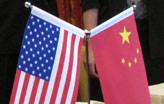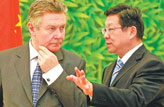Cars
China's auto industry caught in dilemma
Updated: 2011-07-18 09:06
(Xinhua)
CHANGCHUN -- The stunning growth of the world's largest auto market over the past two years has created some serious problems: grid-lock, pollution and energy shortages.
"China's auto industry is caught in a dilemma in the wake of energy supply strains, deteriorating environment and traffic woes," said Cui Jingshu, an auto dealer in Changchun, capital city of the northeastern Jilin province.
Many car dealers in China are feeling the pinch as auto sales plateaued in the first half of the year. Like Cui, many auto makers and dealers came to the ongoing eighth China Changchun Automobile Expo hoping to boost their sales.
The year-on-year growth rate of auto sales slowed to 3.25 percent in the first half of the year, compared with the 30-percent and 50-percent annual growth in 2010 and 2009, respectively, according to data from the China Association of Automobile Manufacturers.
Liu Tienan, head of the National Energy Administration, said the auto industry is a heavy user of resources and contributor to pollution.
"The country saw an increase of 100 million tons in oil production capacity during the 2006-2010 period, only enough to meet the demand of newly-increased autos," Liu said.
According to Liu, the country's primary energy consumption rose 5.9 percent year-on-year to 3.25 billion tons of coal equivalent last year, making it the world's second largest energy consumer after the US.
"If calculated by one ton of oil a car uses up per year, the current 200 million tons of annual gasoline and diesel oil supply can only support a maximum of 200 million vehicles," said Jiang Jun, a researcher with Jilin Academy of Social Sciences.
According to Jiang, vehicle exhaust has become a major source of air pollution in the country.
"About one third of the 100 major cities across the country failed to meet air quality standards during recent years, for which vehicle emissions should be blamed," Jiang said.
The country has pledged to reduce both energy consumption and carbon emissions per unit of economic output by 18 percent over the next five years, as part of its wider plan to cut the carbon use per unit of GDP by 40 to 45 percent by 2020 from 2005 levels.
The fact that more cities are suffering from traffic congestion has also cast a shadow over the auto industry.
To combat growing traffic woes, Beijing adopted a raft of measures including hiking parking charges in downtown areas and a car-quota system, which allows only 240,000 new cars to be registered in the city this year, compared with the 800,000 units that took to the streets in 2010.
Guo Jifu, director of the Beijing Transport Research Center, said the city is likely to register 7 million vehicles by 2015, but it can only accommodate a maximal 6.7 million vehicles.
"By then, people could only drive at a jogging speed of 15 kilometers per hour on average," Guo said.
As conflicts between the development of auto industry and the broader society begin to manifest themselves, experts suggest that the auto industry should slow its pace of growth.
"The drop in auto sales is indeed huge. But it's also an opportunity for the sector to correct itself toward more healthy development," said Yu Tiantian, researcher with Jilin North Automobile Industry Information Development Co Ltd.
Noting that the auto sector currently displays a pyramid structure with luxury cars on the top, joint-stock and home-grown brands in the middle and at the bottom, Yu suggested that Chinese auto makers should adjust the structure by reducing shares of the low-end market while increasing efforts to enter the middle market.
"Home-grown brands have long been at the bottom of the profit chain as the biggest share is always taken away by imported cars and joint-stock brands," Yu said.
Song Donglin, head of Jilin University of Finance and Economics, said the country's auto industry, though huge in terms of scale, is rather weak.
Citing the example of Japan's earthquake, which disrupted auto production worldwide as the country controls the key technologies of major components, Song urged the auto sector to break the bottleneck of technologies to become stronger.
"The government should encourage capital-rich auto firms to boost technological research and innovation through financing and policy supports, while working to link research programs to the practical needs," Song said.
According to Jiang, the industry restructuring, which is the only way for the country to become an auto powerhouse, is inescapable for any market when developing into a certain phase.
"It will be a painful year for many sectors, as the government is resolved to upgrade the industries such as the auto and steel ones to promote healthy, sound development in the 12th Five-Year Plan (2011-2015) period," Jiang said.

Specials

China-US Governors Forum
The first China-US Governors Forum is held July 15 in the Salt Lake City, the United States.

My China story
Foreign readers are invited to share your China stories.

Rare earths export quota
China kept its export quota at almost the same level as last year.